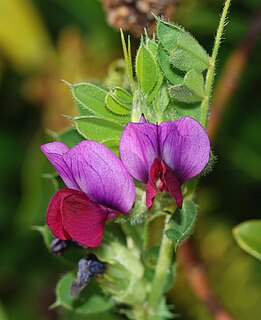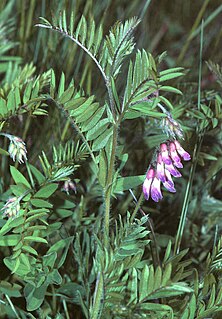
Amygdalin is a naturally occurring chemical compound best known for being falsely promoted as a cancer cure. It is found in many plants, but most notably in the seeds (kernels) of apricots, bitter almonds, apples, peaches, and plums.

A cyanide is a chemical compound that contains the group C≡N. This group, known as the cyano group, consists of a carbon atom triple-bonded to a nitrogen atom.

Vicia sativa, known as the common vetch, garden vetch, tare or simply vetch, is a nitrogen-fixing leguminous plant in the family Fabaceae. Although considered a weed when found growing in a cultivated grainfield, this hardy plant is often grown as green manure or livestock fodder.

Macadamia is a genus of four species of trees indigenous to Australia, and constituting part of the plant family Proteaceae. They are native to northeastern New South Wales and central and southeastern Queensland specifically. Three species of the genus are commercially important for their fruit, the macadamia nut. Global production in 2015 was 160,000 tonnes. Other names include Queensland nut, bush nut, maroochi nut, bauple nut and Hawaii nut. In Australian Aboriginal languages, the fruit is known by names such as bauple, gyndl, jindilli and boombera. It was an important source of bushfood for the Aboriginal peoples who are the original inhabitants of the area.
A glucoside is a glycoside that is derived from glucose. Glucosides are common in plants, but rare in animals. Glucose is produced when a glucoside is hydrolysed by purely chemical means, or decomposed by fermentation or enzymes.

Pyracantha is a genus of large, thorny evergreen shrubs in the family Rosaceae, with common names firethorn or pyracantha. They are native to an area extending from Southwest Europe east to Southeast Asia. They resemble and are related to Cotoneaster, but have serrated leaf margins and numerous thorns.

Elaeagnus angustifolia, commonly called Russian olive, silver berry, oleaster, or wild olive, is a species of Elaeagnus, native to western and central Asia, Iran, from southern Russia and Kazakhstan to Turkey, and parts of Pakistan. As of 2020, it is widely established in North America as an introduced species.

Vicia is a genus of about 140 species of flowering plants that are part of the legume family (Fabaceae), and which are commonly known as vetches. Member species are native to Europe, North America, South America, Asia and Africa. Some other genera of their subfamily Faboideae also have names containing "vetch", for example the vetchlings (Lathyrus) or the milk-vetches (Astragalus). The broad bean is sometimes separated in a monotypic genus Faba; although not often used today, it is of historical importance in plant taxonomy as the namesake of the order Fabales, the Fabaceae and the Faboideae. The tribe Vicieae in which the vetches are placed is named after the genus' current name. Among the closest living relatives of vetches are the lentils (Lens) and the true peas (Pisum).

Prunus serotina, commonly called black cherry, wild black cherry, rum cherry, or mountain black cherry, is a deciduous tree or shrub of the genus Prunus. Despite being called black cherry, it is not very closely related to the commonly cultivated cherries such as sweet cherry, sour cherry and Japanese flowering cherries which belong to Prunus subg. Cerasus. Instead, P. serotina belongs to Prunus subg. Padus, a subgenus also including Eurasian bird cherry and chokecherry. The species is widespread and common in North America and South America.

Araucaria angustifolia, the Paraná pine, Brazilian pine or candelabra tree, is a critically endangered species in the conifer genus Araucaria. Although the common names in various languages refer to the species as a "pine", it does not belong in the genus Pinus.
Rubber seed oil is oil extracted from the seeds of rubber trees. In the latex manufacturing process, rubber seeds are not historically collected and commercialized. Recent analysis shows that rubber seed oil contained the following fatty acids:

Procyanidins are members of the proanthocyanidin class of flavonoids. They are oligomeric compounds, formed from catechin and epicatechin molecules. They yield cyanidin when depolymerized under oxidative conditions.

Lotaustralin is a cyanogenic glucoside found in small amounts in Fabaceae austral trefoil, cassava, lima bean, roseroot and white clover, among other plants. Lotaustralin is the glucoside of methyl ethyl ketone cyanohydrin and is structurally related to linamarin, the acetone cyanohydrin glucoside also found in these plants. Both lotaustralin and linamarin may be hydrolyzed by the enzyme linamarase to form glucose and a precursor to the toxic compound hydrogen cyanide.
In enzymology, a prunasin beta-glucosidase (EC 3.2.1.118) is an enzyme that catalyzes the chemical reaction
Hiroyoshi Ohashi is a botanist formerly at the University of Tokyo and Tohoku University. He began publishing on Japanese Arisaema in the early 1960s. He published a couple of miscellaneous notes on Arisaema in 1963 and 1964 and these were followed by a revision of the genus for Japan jointly published in 1980 with J. Murata, and by the Araceae treatment for the Wildflowers of Japan.

(R)-prunasin is a cyanogenic glycoside related to amygdalin. Chemically, it is the glucoside of (R)-mandelonitrile.
Tyrosine N-monooxygenase (EC 1.14.13.41, tyrosine N-hydroxylase, CYP79A1) is an enzyme with systematic name L-tyrosine,NADPH:oxygen oxidoreductase (N-hydroxylating). This enzyme catalyses the following chemical reaction
Isoleucine N-monooxygenase (EC 1.14.13.117, CYP79D3, CYP79D4) is an enzyme with systematic name L-isoleucine,NADPH:oxygen oxidoreductase (N-hydroxylating). This enzyme catalyses the following chemical reaction
Valine N-monooxygenase (EC 1.14.13.118, CYP79D1, CYP79D2) is an enzyme with systematic name L-valine,NADPH:oxygen oxidoreductase (N-hydroxylating). This enzyme catalyses the following chemical reaction

Vicianose is a disaccharide.













